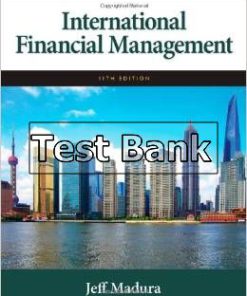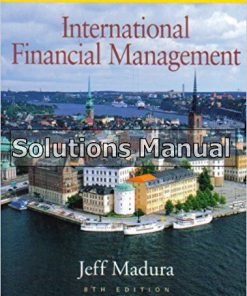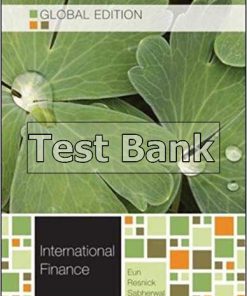International Financial Management 8th Edition Eun Test Bank
You may also like
This is completed downloadable of International Financial Management 8th Edition Eun Test Bank

Product Details:
- ISBN-10 : 125971778X
- ISBN-13 : 978-1259717789
- Author:
International Financial Management provides students with a foundation for analysis that will serve them well in their careers ahead. The decision-making process is presented through the text with the goal of teaching students how to make informed managerial decisions in an evolving global financial landscape. And new to this edition, McGraw-Hill’s Connect® empowers students by continually adapting to deliver precisely what they need, when they need it, and how they need it, so your class time is more engaging and effective.
Table of Content:
- PART ONE Foundations of International Financial Management
- CHAPTER 1 Globalization and the Multinational Firm
- What’s Special about International Finance?
- Foreign Exchange and Political Risks
- Market Imperfections
- Expanded Opportunity Set
- Goals for International Financial Management
- Globalization of the World Economy: Major Trends and Developments
- Emergence of Globalized Financial Markets
- Emergence of the Euro as a Global Currency
- Europe’s Sovereign Debt Crisis of 2010
- Trade Liberalization and Economic Integration
- Privatization
- Global Financial Crisis of 2008–2009
- Multinational Corporations
- Summary
- MINI CASE: Nike and Sweatshop Labor
- APPENDIX 1A: Gain from Trade: The Theory of Comparative Advantage
- CHAPTER 2 International Monetary System
- Evolution of the International Monetary System
- Bimetallism: Before 1875
- Classical Gold Standard: 1875–1914
- Interwar Period: 1915–1944
- Bretton Woods System: 1945–1972
- The Flexible Exchange Rate Regime: 1973–Present
- The Current Exchange Rate Arrangements
- European Monetary System
- The Euro and the European Monetary Union
- A Brief History of the Euro
- What Are the Benefits of Monetary Union?
- Costs of Monetary Union
- Prospects of the Euro: Some Critical Questions
- INTERNATIONAL FINANCE IN PRACTICE: Mundell Wins Nobel Prize in Economics
- The Mexican Peso Crisis
- The Asian Currency Crisis
- Origins of the Asian Currency Crisis
- Lessons from the Asian Currency Crisis
- The Argentine Peso Crisis
- Fixed versus Flexible Exchange Rate Regimes
- Summary
- MINI CASE: Grexit or Not?
- CHAPTER 3 Balance of Payments
- Balance-of-Payments Accounting
- Balance-of-Payments Accounts
- The Current Account
- The Capital Account
- Statistical Discrepancy
- Official Reserve Account
- The Balance-of-Payments Identity
- Balance-of-Payments Trends in Major Countries
- INTERNATIONAL FINANCE IN PRACTICE: The Dollar and the Deficit
- Summary
- MINI CASE: Mexico’s Balance-of-Payments Problem
- APPENDIX 3A: The Relationship Between Balance of Payments and National Income Accounting
- CHAPTER 4 Corporate Governance Around the World
- Governance of the Public Corporation: Key Issues
- The Agency Problem
- Remedies for the Agency Problem
- Board of Directors
- Incentive Contracts
- INTERNATIONAL FINANCE IN PRACTICE: When Boards Are All in the Family
- Concentrated Ownership
- Accounting Transparency
- Debt
- Overseas Stock Listings
- Market for Corporate Control
- Law and Corporate Governance
- Consequences of Law
- Ownership and Control Pattern
- Private Benefits of Control
- Capital Markets and Valuation
- Corporate Governance Reform
- Objectives of Reform
- Political Dynamics
- The Sarbanes-Oxley Act
- The Cadbury Code of Best Practice
- The Dodd-Frank Act
- Summary
- MINI CASE: Parmalat: Europe’s Enron
- PART TWO The Foreign Exchange Market, Exchange Rate Determination, and Currency Derivatives
- CHAPTER 5 The Market for Foreign Exchange
- Function and Structure of the FX Market
- INTERNATIONAL FINANCE IN PRACTICE: The Mouse Takes Over the Floor
- FX Market Participants
- Correspondent Banking Relationships
- The Spot Market
- Spot Rate Quotations
- INTERNATIONAL FINANCE IN PRACTICE: Where Money Talks Very Loudly
- Cross-Exchange Rate Quotations
- Alternative Expressions for the Cross-Exchange Rate
- The Bid-Ask Spread
- Spot FX Trading
- The Cross-Rate Trading Desk
- Triangular Arbitrage
- Spot Foreign Exchange Market Microstructure
- The Forward Market
- Forward Rate Quotations
- Long and Short Forward Positions
- Non-Deliverable Forward Contracts
- Forward Cross-Exchange Rates
- Forward Premium
- Swap Transactions
- Exchange-Traded Currency Funds
- Summary
- MINI CASE: Shrewsbury Herbal Products, Ltd.
- CHAPTER 6 International Parity Relationships and Forecasting Foreign Exchange Rates
- Interest Rate Parity
- Covered Interest Arbitrage
- Interest Rate Parity and Exchange Rate Determination
- Currency Carry Trade
- Reasons for Deviations from Interest Rate Parity
- Purchasing Power Parity
- PPP Deviations and the Real Exchange Rate
- Evidence on Purchasing Power Parity
- INTERNATIONAL FINANCE IN PRACTICE: McCurrencies
- Fisher Effects
- Forecasting Exchange Rates
- Efficient Market Approach
- Fundamental Approach
- Technical Approach
- Performance of the Forecasters
- Summary
- MINI CASE: Turkish Lira and Purchasing Power Parity
- APPENDIX 6A: Purchasing Power Parity and Exchange Rate Determination
- CHAPTER 7 Futures and Options on Foreign Exchange
- Futures Contracts: Some Preliminaries
- Currency Futures Markets
- INTERNATIONAL FINANCE IN PRACTICE: FX Market Volumes Surge
- Basic Currency Futures Relationships
- Options Contracts: Some Preliminaries
- Currency Options Markets
- Currency Futures Options
- Basic Option-Pricing Relationships at Expiration
- American Option-Pricing Relationships
- European Option-Pricing Relationships
- Binomial Option-Pricing Model
- European Option-Pricing Formula
- Empirical Tests of Currency Options
- Summary
- MINI CASE: The Options Speculator
- PART THREE Foreign Exchange Exposure and Management
- CHAPTER 8 Management of Transaction Exposure
- Three Types of Exposure
- Forward Market Hedge
- Money Market Hedge
- Options Market Hedge
- Hedging Foreign Currency Payables
- Forward Contracts
- Money Market Instruments
- Currency Options Contracts
- Cross-Hedging Minor Currency Exposure
- Hedging Contingent Exposure
- Hedging Recurrent Exposure with Swap Contracts
- Hedging through Invoice Currency
- Hedging via Lead and Lag
- Exposure Netting
- Should the Firm Hedge?
- What Risk Management Products Do Firms Use?
- Summary
- MINI CASE: Airbus’ Dollar Exposure
- CASE APPLICATION: Richard May’s Options
- CHAPTER 9 Management of Economic Exposure
- How to Measure Economic Exposure
- Operating Exposure: Definition
- Illustration of Operating Exposure
- Determinants of Operating Exposure
- Managing Operating Exposure
- Selecting Low-Cost Production Sites
- Flexible Sourcing Policy
- Diversification of the Market
- R&D Efforts and Product Differentiation
- Financial Hedging
- CASE APPLICATION: Exchange Risk Management at Merck
- Summary
- MINI CASE: Economic Exposure of Albion Computers PLC
- CHAPTER 10 Management of Translation Exposure
- Translation Methods
- Current/Noncurrent Method
- Monetary/Nonmonetary Method
- Temporal Method
- Current Rate Method
- Financial Accounting Standards Board Statement 8
- Financial Accounting Standards Board Statement 52
- The Mechanics of the FASB 52 Translation Process
- Highly Inflationary Economies
- International Accounting Standards
- CASE APPLICATION: Consolidation of Accounts according to FASB 52: The Centralia Corporation
- Management of Translation Exposure
- Translation Exposure versus Transaction Exposure
- Hedging Translation Exposure
- Balance Sheet Hedge
- Derivatives Hedge
- Translation Exposure versus Operating Exposure
- Empirical Analysis of the Change from FASB 8 to FASB 52
- Summary
- MINI CASE: Sundance Sporting Goods, Inc.
- PART FOUR World Financial Markets and Institutions
- CHAPTER 11 International Banking and Money Market
- International Banking Services
- The World’s Largest Banks
- Reasons for International Banking
- Types of International Banking Offices
- Correspondent Bank
- Representative Offices
- Foreign Branches
- Subsidiary and Affiliate Banks
- Edge Act Banks
- Offshore Banking Centers
- International Banking Facilities
- Capital Adequacy Standards
- International Money Market
- Eurocurrency Market
- ICE LIBOR
- Eurocredits
- INTERNATIONAL FINANCE IN PRACTICE: The Rotten Heart of Finance
- Forward Rate Agreements
- Euronotes
- Eurocommercial Paper
- Eurodollar Interest Rate Futures Contracts
- International Debt Crisis
- History
- Debt-for-Equity Swaps
- The Solution: Brady Bonds
- The Asian Crisis
- Global Financial Crisis
- The Credit Crunch
- Impact of the Financial Crisis
- Economic Stimulus
- The Aftermath
- Summary
- MINI CASE: Detroit Motors’ Latin American Expansion
- APPENDIX 11A: Eurocurrency Creation
- CHAPTER 12 International Bond Market
- The World’s Bond Markets: A Statistical Perspective
- Foreign Bonds and Eurobonds
- Bearer Bonds and Registered Bonds
- National Security Regulations
- Withholding Taxes
- Security Regulations that Ease Bond Issuance
- Global Bonds
- Types of Instruments
- INTERNATIONAL FINANCE IN PRACTICE: SOX and Bonds
- Straight Fixed-Rate Issues
- Euro-Medium-Term Notes
- Floating-Rate Notes
- Equity-Related Bonds
- Dual-Currency Bonds
- Currency Distribution, Nationality, and Type of Issuer
- International Bond Market Credit Ratings
- INTERNATIONAL FINANCE IN PRACTICE: Heineken Refreshes Euromarket with Spectacular Unrated Bonds
- Eurobond Market Structure and Practices
- Primary Market
- Secondary Market
- Clearing Procedures
- International Bond Market Indexes
- Summary
- MINI CASE: Sara Lee Corporation’s Eurobonds
- CHAPTER 13 International Equity Markets
- A Statistical Perspective
- Market Capitalization
- Measure of Liquidity
- Market Structure, Trading Practices, and Costs
- Market Consolidations and Mergers
- Trading in International Equities
- Cross-Listing of Shares
- Yankee Stock Offerings
- American Depository Receipts
- Global Registered Shares
- Empirical Findings on Cross-Listing and ADRs
- International Equity Market Benchmarks
- iShares MSCI
- Factors Affecting International Equity Returns
- Macroeconomic Factors
- INTERNATIONAL FINANCE IN PRACTICE: Foreign Interest in South Africa Takes Off
- Exchange Rates
- Industrial Structure
- Summary
- MINI CASE: San Pico’s New Stock Exchange
- CHAPTER 14 Interest Rate and Currency Swaps
- Types of Swaps
- INTERNATIONAL FINANCE IN PRACTICE: The World Bank’s First Currency Swap
- Size of the Swap Market
- The Swap Bank
- Swap Market Quotations
- INTERNATIONAL FINANCE IN PRACTICE: Double-Crossed
- Interest Rate Swaps
- Basic Interest Rate Swap
- Pricing the Basic Interest Rate Swap
- Currency Swaps
- Basic Currency Swap
- Equivalency of Currency Swap Debt Service Obligations
- Pricing the Basic Currency Swap
- A Basic Currency Swap Reconsidered
- Variations of Basic Interest Rate and Currency Swaps
- Risks of Interest Rate and Currency Swaps
- Is the Swap Market Efficient?
- Summary
- MINI CASE: The Centralia Corporation’s Currency Swap
- CHAPTER 15 International Portfolio Investment
- International Correlation Structure and Risk Diversification
- Optimal International Portfolio Selection
- Effects of Changes in the Exchange Rate
- International Bond Investment
- International Mutual Funds: A Performance Evaluation
- International Diversification through Country Funds
- International Diversification with ADRs
- International Diversification with Exchange-Traded Funds
- International Diversification with Hedge Funds
- Why Home Bias in Portfolio Holdings?
- International Diversification with Small-Cap Stocks
- Summary
- MINI CASE: Solving for the Optimal International Portfolio
- APPENDIX 15A: International Investment with Exchange Risk Hedging
- APPENDIX 15B: Solving for the Optimal Portfolio
- PART FIVE Financial Management of the Multinational Firm
- CHAPTER 16 Foreign Direct Investment and Cross-Border Acquisitions
- Global Trends in FDI
- Why Do Firms Invest Overseas?
- Trade Barriers
- Imperfect Labor Market
- Intangible Assets
- Vertical Integration
- INTERNATIONAL FINANCE IN PRACTICE: Linear Sequence in Manufacturing: Singer & Company
- Product Life Cycle
- Shareholder Diversification Services
- Cross-Border Mergers and Acquisitions
- Political Risk and FDI
- Summary
- MINI CASE: Enron versus Bombay Politicians
- CHAPTER 17 International Capital Structure and the Cost of Capital
- Cost of Capital
- Cost of Capital in Segmented versus Integrated Markets
- Does the Cost of Capital Differ among Countries?
- CASE APPLICATION: Novo Industri
- Cross-Border Listings of Stocks
- Capital Asset Pricing under Cross-Listings
- The Effect of Foreign Equity Ownership Restrictions
- Pricing-to-Market Phenomenon
- CASE APPLICATION: Nestlé
- Asset Pricing under Foreign Ownership Restrictions
- The Financial Structure of Subsidiaries
- Summary
- APPENDIX 17A: Pricing of Nontradable Assets: Numerical Simulations
- CHAPTER 18 International Capital Budgeting
- Review of Domestic Capital Budgeting
- The Adjusted Present Value Model
- Capital Budgeting from the Parent Firm’s Perspective
- Generality of the APV Model
- Estimating the Future Expected Exchange Rate
- CASE APPLICATION: The Centralia Corporation
- Risk Adjustment in the Capital Budgeting Analysis
- Sensitivity Analysis
- Purchasing Power Parity Assumption
- Real Options
- Summary
- MINI CASE 1: Dorchester, Ltd.
- MINI CASE 2: Strik-it-Rich Gold Mining Company
- CHAPTER 19 Multinational Cash Management
- The Management of International Cash Balances
- CASE APPLICATION: Teltrex’s Cash Management System
- Bilateral Netting of Internal and External Net Cash Flows
- Reduction in Precautionary Cash Balances
- Cash Management Systems in Practice
- Summary
- MINI CASE 1: Efficient Funds Flow at Eastern Trading Company
- MINI CASE 2: Eastern Trading Company’s New MBA
- CHAPTER 20 International Trade Finance
- A Typical Foreign Trade Transaction
- Forfaiting
- Government Assistance in Exporting
- INTERNATIONAL FINANCE IN PRACTICE: First Islamic Forfaiting Fund Set Up
- The Export-Import Bank and Affiliated Organizations
- Countertrade
- Forms of Countertrade
- INTERNATIONAL FINANCE IN PRACTICE: Armed Forces Tops in Countertrade List
- Some Generalizations about Countertrade
- Summary
- MINI CASE: American Machine Tools, Inc.
- CHAPTER 21 International Tax Environment and Transfer Pricing
- The Objectives of Taxation
- Tax Neutrality
- Tax Equity
- Types of Taxation
- Income Tax
- Withholding Tax
- Value-Added Tax
- National Tax Environments
- Worldwide Taxation
- Territorial Taxation
- Foreign Tax Credits
- Organizational Structures
- Branch and Subsidiary Income
- Tax Havens
- Controlled Foreign Corporation
- Tax Inversion
- INTERNATIONAL FINANCE IN PRACTICE: On or Off? It’s a Matter of Degree
- Transfer Pricing and Related Issues
- CASE APPLICATION: Mintel Products Transfer Pricing Strategy
- INTERNATIONAL FINANCE IN PRACTICE: Transfer Pricing: An Important International Tax Issue
- Miscellaneous Factors
- INTERNATIONAL FINANCE IN PRACTICE: Wake Up and Smell the Coffee
- Advance Pricing Agreement
- Blocked Funds
- Summary
- MINI CASE 1: Sigma Corp.’s Location Decision
- MINI CASE 2: Eastern Trading Company’s Optimal Transfer Pricing Strategy
- Glossary
- Index
People Also Search:
international financial management eun
international financial management 8th edition eun
international financial management
international financial management 8th edition
international financial management 8th edition testbank download pdf
international financial management 8th edition download scribd
financial accounting for mbas 8th edition ebook












